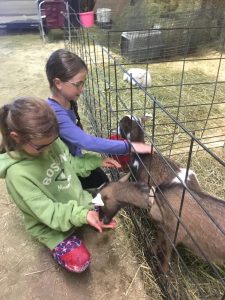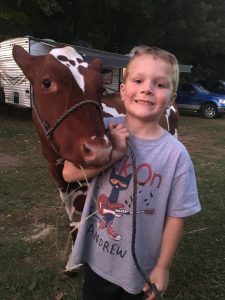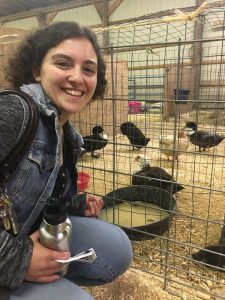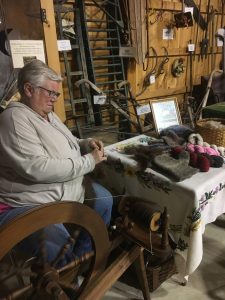
Oct 13, 2017 | Feature |
By Gwen Baker – Contributing Writer
For many people at the Farmington Fair, the animals are an instant attraction. Fairgoers get to see a wide range of unique animals such as goats, cows and ducks.

Scout and Summit with their mother
(Scout: 8 years, top in purple and Summit: 7 years, bottom in green)
“What’s your name?”
“S-C-O-U-T,” replies Scout.
“And what’s your name sweetheart?”
“Summit.”
“How old are you two?”
“I’m eight,” says Scout
“Seven,” says Summit.
“Why are you drawn to the goats?”
“Cuz they’re cute and fluffy,” says Scout.
“And they’re lickable,” laughs Summit.
“Not likeable, but lickable?” asks their Mother.
“And they’re all different,” Scout adds.
“Do you guys go to the Farmington Fair every year?”
“We don’t come every year, as much as we can,” said their mother. “We live in Livermore.” The mother and the two girls moved down the enclosure to another group of goats.
“These guys like you better,” she said. The goats move towards the girls, sticking their heads through the wire. Both the girls kneel down and began patting the goats through the fence.
“Easy Summit they bite,” her mother advised.
“I know,” she replied.

Becca Beatty
(UMF student Becca Beatty poses with cow)
“Why do you like cows?”
“I first realized how awesome cows were on a family vacation to a farm in NH. I watched a baby cow get born and I also got to milk a cow. I asked my mom if we could get a cow and she said no! Every year during fair season, I try to convince her to let me buy a cow. If I were to buy a cow I would want it to be like a pet dog, it would live inside with me, but I don’t think I would fit inside my apartment. They’re like big dogs and I like dogs… and they lick my face.” She pointed to a baby cow. “I wouldn’t have space for a full grown cow, but possibly a baby. I could fit that size into my apartment. My mom however would not be impressed.” The cow started to lick her face. Laughing hysterically, she told it to stay still so it could pose for the camera. “It’s licking my face… It feels like a cat’s tongue only pricklier,” giggled Beatty.

Andrew with Mother Lilly Bagley
(Andrew, age 8 years with Georgia)
“How long have you had the cows and what are their names and breed?”
“We’ve grown up with dairy cattle. It’s kinda our passion,” explained Lilly Bagley. “So we have three Milking Shorthorn and one Ayrshire. And we’ve had them for about two years now,” said Bagley. Pointing towards the fence where the four cows were, she began describing the cows.
“I have Rhonda to the left, and Georgia on the right of the pen. And then I have Gargamel, like from the Smurf Gargamel; she’s the brown one and Frozen, (far right) she’s considered a roan, the coloration of her is considered roan.”
4-H is a program that children from 5-18 can participate in and be involved in different projects, from agriculture to arts and crafts to robotics. Most clubs meet once a month and discuss business and come up with plans that members can do in their project.
“My oldest son [Jason] is able to be in 4-H now so he’s able to work with his own animals,” said Bagley. “My husband and I grew up with dairy cattle, went to college and kinda got out of it, then went back into it when the kids were old enough. He’s [Andrew] almost old enough.”
“To participate in 4h, they have to be nine. And then they do little classes for kids five to eight,” said Bagley.
“My favorite thing about raising dairy cattle is the bond that you form between each animal and that each heifer has its own personality.”

UMF student Elina Shapiro
(Elina Shapiro with Muscovy duck)
“Tell me a little bit about why you like birds?”
“I really have liked birds ever since I took Ornithology my freshman year in college. I took it actually in North Carolina, where I grew up, and ever since I took the class I fell in love with birds,” Shapiro reminisced.
“I’m an avid bird watcher and I love their diversity. I love seeing all the different kinds of birds while I’m out there and though I’d much prefer being out in the field and seeing birds, a lot of the birds that are in here, I have seen in the field.”
She pointed to the duck next to her. “One of which, one of the birds in here called the Muscovy duck was actually very prevalent right near my house and at the campus, I was at where I took Ornithology. It looks kind of funny, so every time I see it, it brings humor I guess you could say. It looks kinda like a combination of a chicken and turkey with warts. I mean it just looks very strange,” Shapiro laughed.
“I love bird watching. I also did a lot of bluebird research for two summers. So bluebirds are my favorite. I wouldn’t call that one my favorite [Muscovy duck], but it brings humor because it looks so funny,” said Shapiro.

Diane Bolduc spins alpaca yarn on the machine.
“How long have you been spinning?”
“[I’ve been spinning for] twenty-seven years, I’ve been coming [to the Farmington Fair] for thirteen,” said Bolduc.
“What is the process of spinning, how does the machine work?”
“The process is shearing from a sheep or an alpaca, washing and carting it, combing it, then spinning it. I decide how thick or thin I want my yarn to be by thinning it out here. I pull it and thin it out and the spinning wheel twists it. All the spinning wheel does it twist it, and when I’m ready, I let it go. It runs through, it goes through the hole, comes out the others side and runs across these little hooks and winds up at the bobbin,” Bolduc replied, her hands swiftly gesticulating the movements as she demonstrates the process.
“And then when I’m all done I will apply it back on itself, which is twisting the two together, and it will be yarn ready to knit or crochet with,” said Bolduc.
“Does it take practice to get the handle of it?”
“Absolutely, it takes practice. When I first started, I was making rope. It was huge, it was thick, it was overspun. But it’s like anything, the more you do it, the better you get. The more practice. It’s a very touch feel, hands on type of activity. And once you learn how to do it, it’s like riding your bike; you have it forever.” She continued to spin, focusing on the process.
She later mentioned how children on class field trips call the sheep that are colored “Easter sheep.” as well as her amusement when men specifically ask her if they “really have sheep that color.”

Sep 23, 2017 | News |
Bryan Eldridge – Contributing Writer

The newly installed patio next to Mantor Library
(Photo by Bryan Eldridge)
UMF students are fully embracing the new patio in front of Mantor Library that was constructed over the summer, giving the campus its newest popular gathering spot.
The patio consists of three umbrella covered tables overlooking the Mantor green. With four seats placed at each table, the spacious seating area is often fully utilized.
Keenan Farwell, the Grounds Facilities Manager for UMF, lead the team that built UMF’s newest addition. Farwell has been the Grounds Manager for a year and a half. Coming into this role felt quite familiar for Farwell, having to own his own business in the field of hardscape.
Farwell noted that the enhanced seating and continuous use of the patio are both effective outcomes of the new install. “It created more seating area,” said Farwell. “It gets quite a bit of use at this point, even the lower seating wall.”
The patio was intentionally built with more than just seating in mind. “We put power in also so, we can house bands on top of there to play out over the green,” said Farwell.
Matt Breer, a senior at UMF and a new employee for the Mantor Library this year, noticed the interest that’s being taken.
“I think people really enjoy the patio being there,” he said. “The patio’s installment has done more than just attracting students; it’s also attracting business. During normal school hours, there is usually only one free table (in the library),” said Breer, adding that “giving people a choice of where they can sit gives them a lot more freedom, and when people have those kinds of freedoms they’re more likely to give business.”
The grounds crew are responsible for the patio’s construction but aren’t the only set of employees to thank for the campus’ upkeep and appearance. The grounds crew for facilities often collaborates with the maintenance employees to make UMF look the way it does.
Tim Burnell, a longtime custodian at UMF, works in Purington hall and noticed the comradery. “There’s a lot of teamwork that’s going on with all the groups here in facilities,” Burnell said.
Nick Richards has been the custodial manager on campus for 14 months and noted the importance of both aspects of facilities working together to maintain both the grounds and the building upkeep. “Those two groups have to work together closely to make sure that all these areas are taken care of,” said Richards.
Both UMF employees were very student-driven when it came to their favorite aspects of the job. “Trying to provide the best customer service that we can and making sure that the students are as happy as they can be,” said Richards.
Students that wish to speak to somebody about a maintenance or facilities issue around campus have multiple options including to email facilities directly at facilities.management@umf.com.

Sep 22, 2017 | Feature |
By Gavin Elliott – Contributing Write
After the recent name change approved by Student Senate, UMF Aspiring Educators, previously known as Student M.E.A. (Maine Education Association), seem to be growing in popularity.
Last year, the UMF Aspiring Educators were down to seven to ten members. The level of involvement was higher in the past, according to Beth Evans, a professor at UMF and faculty advisor for Aspiring Educators.
“When I first started teaching here at UMF around 20 years ago, just about every undergrad Ed Major was a member of at least one of the two education clubs,” Evans said.
This year at the first meeting, numbers had tripled when compared to the amount of members last year. This success is partially due to the club’s recent name change.

UMF Aspiring Educators of Maine at the Fall 2017 Club Fair
(Photo by Mitchell Agailb)
According to Stephen Riitano, the president of the Aspiring Educators, “the change was to align with the N.E.A. (National Education Association),” and to “let the students of UMF know that a membership to the student M.E.A. is not necessary, although UMF Aspiring Educators is still affiliated [with them].”
Aspiring Educators also held an Informational Meeting in the Ed Center along with Advocates for Disability Awareness Club (ADAC) and UMF Association for the Education of Young Children (AEYC). Through this meeting, the members of it are very much clubs hoped to inform new students, as well as current students, of what they each do.
Members of Aspiring Educators will often find themselves brainstorming and discussing upcoming events, fundraising, looking at poverty’s impacts on schools, connecting with other educators and learning skills they may not typically receive in their regular classrooms to aid in their professional development.
Professor Evans elaborated, “It is imperative to know what everyone else is doing in this profession. Early childhood to middle to special ed, etc. and this club does a great job of preparing ed students to do just this.”
Evans went on to say “The club is great because the movers and shakers of the professional life we call teaching.”
The treasurer of Aspiring Educators, Carson Hope, says, “The club is great because you get to network with other educators and clubs, and learn about the community part of teaching.” This networking can also impact more people by allowing them to pool their resources, said Evans.
According to Riitano, an example of the clubs pooling of their resources will be seen on September 26th when Kelly-Anne Rush, more commonly known as Crafty Teacher Lady, will be speaking at 5:30 pm in the Landing about how “teachers can be financially smart while providing meaningful and engaging lessons for their students.”
Later in October, they will be hosting Scare Fest, where “a panel of current teachers and administrators come to UMF and discuss the real side of teaching,” Riitano said.
For more information or any questions on the Aspiring Educators, like them on Facebook at “UMF Aspiring Educators of Maine,” or drop into any of their meetings on Wednesdays, room 106 of the Kalikow Education Center at 7:30 pm







